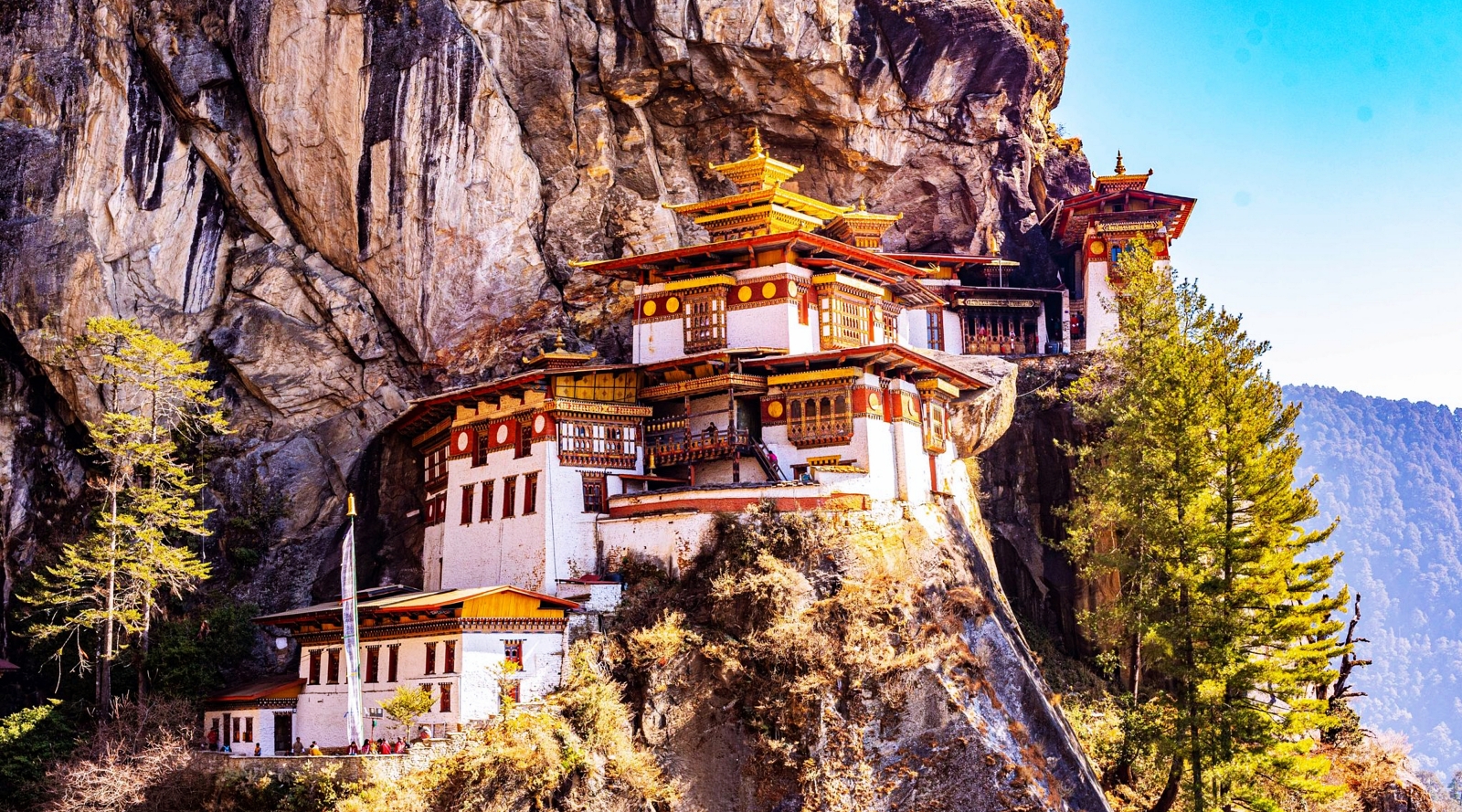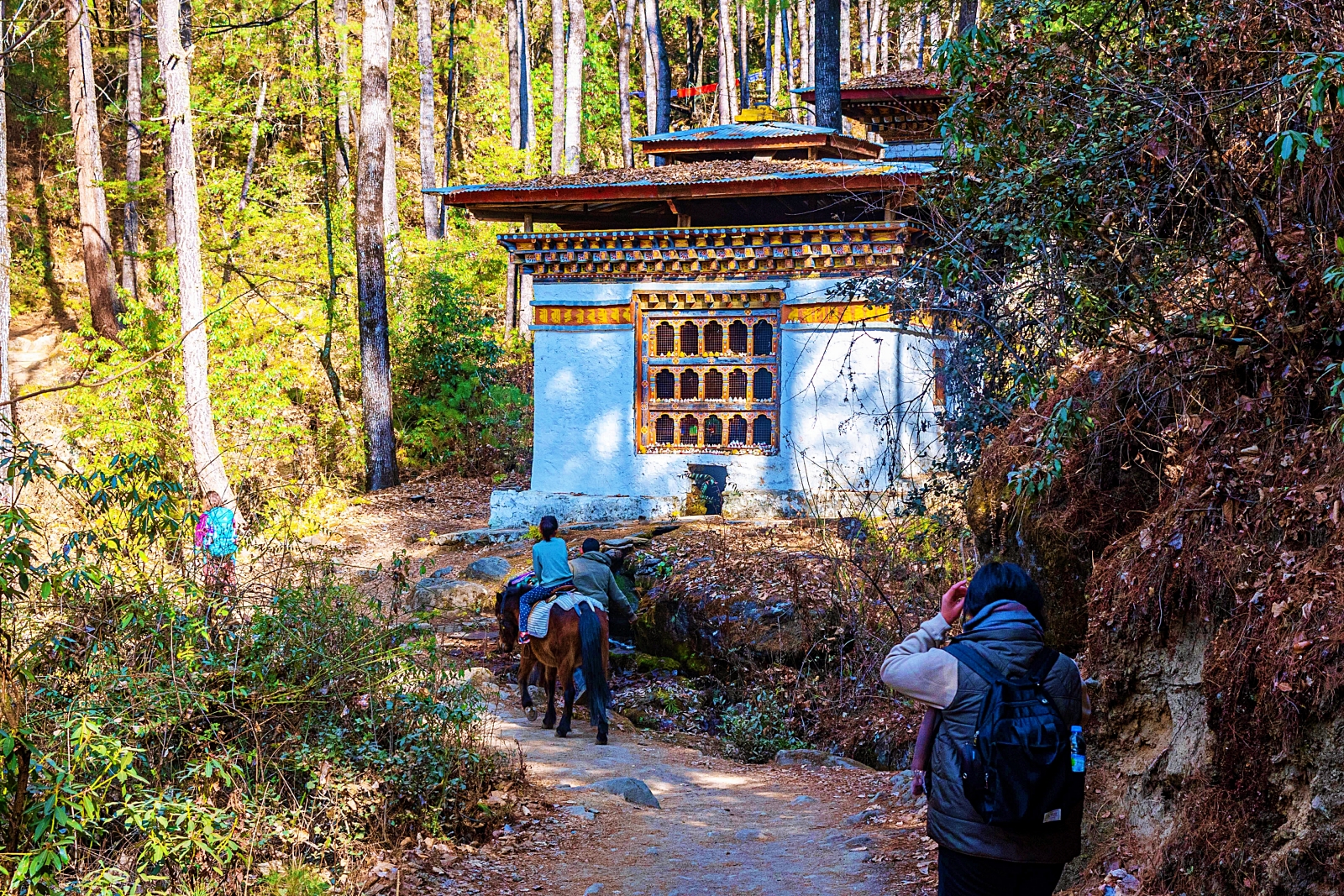How to get to the Tiger’s Nest (Paro Taktsang) Monastery in Bhutan
Perched atop 3,000 metres in the Paro valley, the Paro Taktsang Monastery – more affectionately known as the Tiger’s Nest Monastery was built in 1692.
The Tiger’s Nest is one of the crowning glories of Bhutan, a sight that looks like it’s leapt from the pages of a fairy tale. As soon as we arrived in Bhutan, this was one of the first places I was eager to explore – and it certainly didn’t disappoint! As its name suggests, this majestic structure earned its moniker due to a legendary tale of its origin. That’s right, ‘Taktsang’ literally translates to ‘tigress’s lair’ – now how’s that for a bit of trivia?

Legend tells of an incredible feat performed by the 8th-century Indian Buddhist master Guru Rinpoche; he was taken up a mountain atop the back of a disciple who had transformed herself into a majestic tigress! After arriving at their destination, Guru Rinpoche meditated in the cave for a truly remarkable 3 years, 3 months, 3 days, and 3 hours. After completing his meditation, the cave was said to have been turned into a holy place known as Paro Taktsang.

To get a head start on the Tiger’s Nest trek and maximize our time, we roused ourselves just before sunrise and left Thimphu at a bright ‘n early 7 am. The goal? To arrive at the base of the mountain around 9 am, as the site opens to the public at 8 am. As I approached, I noticed a variety of stalls offering souvenirs, crafts and – much to my surprise – carved wooden walking/hiking sticks for a mere 50 Nu ($0.70).

As we meandered past the stalls, the journey began at a leisurely pace. Through the gate, we strolled across two fields before reaching the foot of the cliff. It was here that the locals kept their fleet of mules and horses, which you can hire to carry you up the rocky path. However, you can only go halfway up the mountain if you chose to ride one of the creatures. We decided to climb – a decision that would pay off.

Even if you’re a pro at riding horses, it’s still nowhere near as comfortable as getting to the Tiger’s Nest on your own two feet. But the reward was worth it – the feeling of accomplishment as we reached the top was amazing! We were ready to take on the challenge, and the ground’s gradual upward slope was all the confirmation we needed – we were officially starting our ascent!
Although nowhere near the majestic Tiger’s Nest yet, I was buzzing with excitement for the trek ahead. As we stepped into the lush, wooded area that blankets the side of the cliff, I realized the ‘difficult’ part of the trail was nothing more than following a steady incline up the face of the mountain. As you tackle the increasingly steep terrain, the winding path between the trees gives you a break from the incline, though some adventurers have cut their own shortcuts.
While these may appear to be the more direct route, they don’t always make for the quickest journey, since these rogue paths are way steeper than the main route. So if you feel like you can manage the gradient, you can try to blaze your own trail – just make sure you don’t get lost in the process! For me, the trek was a wild ride! After an epic journey of scaling the mountain, we finally made it to the rest stop at the halfway point of the Tiger’s Nest trek.
Here, we were blessed with the presence of restrooms and an indoor seating area where we could take a break, grab a snack and refreshments, and even drop off the tired mule – if you hire one. Ah, sweet relief! We paused for a much-needed cuppa tea after trudging up the cliff for what felt like forever. We knew we had to get moving as the day was getting hotter by the minute, so we reluctantly finished our tea and hit the trail once again. Little did we know we had a few hundred metres up and down (and up again, ouch!) to reach the majestic Tiger’s Nest.
After hours of arduous climbing, we were beginning to lose sight of the Tiger’s Nest. But then, as we rounded a corner on an oddly level path, our eyes beheld a breathtaking sight! There it was, perched atop the cliff face, its magnificence radiating out to us. The Tiger’s Nest had been revealed to us, and we stood in awe of its splendour! We were perched atop our platform, looking down upon Tiger’s Nest from the lofty heights above. Beyond the platform, a rope bridge stretched across a small valley, the ends of the bridge adorned with colourful prayer flags that fluttered about in the breeze. Below, a waterfall cascaded down the rocky wall, adding to the majestic beauty of the scene.
As I approached the top of the mountain, I knew that the next part of the trek would be the most challenging yet. To get to the Tiger’s Nest Monastery, I had to traverse the ropes, and climb hundreds of steps down the mountain – only to have to ascend even more steps on the other side. Sure, the descent would be fine, but the thinner air and stifling heat made it seem like an impossible task.
We trudged down the steps to the bottom of the path, feeling the burn with every step. My lungs were gasping for air and I was ready to collapse! But the moment we arrived at the bridge, it was like all our exhaustion disappeared in an instant. We were struck by the peaceful and calming atmosphere, with prayer flags fluttering in the breeze and the mist from the waterfall in the air. It was a truly rejuvenating experience, and afterwards, we were ready to tackle the final leg of our journey—refreshed and reinvigorated!
As I trudged up the seemingly never-ending stairway to the Tiger’s Nest, I was certain the steps were getting steeper (turns out, they weren’t). But despite the challenge, I pushed on and was rewarded with a majestic view of the landscape once I reached the top. It was definitely worth the climb! As we made our way up all the steps to the Tiger’s Nest, we reluctantly relinquished our cameras and phones and left our shoes behind. We stopped to take one last sweeping view of the valley before we crossed the threshold into the Tiger’s Nest Monastery and felt a sudden wave of relief come over us.
The Bhutanese say that simply stepping foot inside the monastery will bring you a lifetime’s worth of blessings – so it was no surprise to see many people entering with their hands clasped in prayer. To explore the inner sanctum of the Tiger’s Nest Monastery, we decided to join one of its guided tours. It was led by a monk who was a permanent resident. Nestled among the breathtaking Himalayan peaks, Paro Takstang stands majestically as a living monastery. Boasting four majestic temples and residential quarters fit for the monks, it serves as an active pilgrimage site for tourists from all around the world.
Here, spiritual seekers and tourists alike are welcomed to bask in its serene atmosphere, as the temple stands as a timeless monument of culture and religion. After your epic journey through the Tiger’s Nest, your next move is to hit the trail and head back to the starting point while capturing all those postcard-worthy shots. This experience will surely stay with you forever – and it’s something you can definitely look back on with fondness!
Opening Hours: Visit Tiger’s Nest Monastery, open from 8 am to 1 pm and then again from 2 pm to 6 pm
Cost: If you’re a tourist to Bhutan, you’ll pay the tourist fee which includes a spectacular trek to the renowned Tiger’s Nest, all arranged for you by your tour guide! But for all the Bhutanese out there, entry to the majestic Paro Taktsang is free, provided you’re wearing the national dress. For foreign residents and Indian tourists, you’ll need to pay 2000 Ngultrum, which is around just $25
What to bring: Pack your hiking shoes, a hiking outfit, water, and a hiking stick. Don’t forget to also throw in your nausea medication – it’s better to be safe than sorry!
When to visit: If you’re looking for the ideal time of year to visit Bhutan, you might want to skip summer. Temperatures can be scorching, and if you don’t want to sweat your way through your trip, we’d suggest spring or fall.



